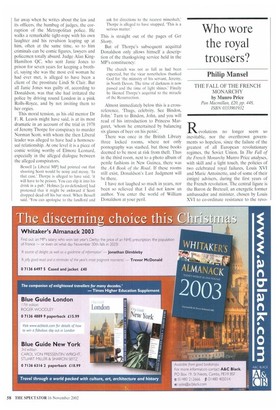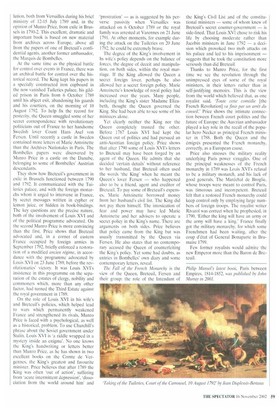Who wore the royal trousers?
Philip Mansel
THE FALL OF THE FRENCH MONARCHY by Munro Price Pan Macmillan, £20, pp, 448, ISBN 0333901932 Revolutions no longer seem so inevitable, nor the overthrown governments so hopeless, since the failure of the greatest of all European revolutionary regimes, the Soviet Union. In The Fall of the French Monarchy Munro Price analyses, with skill and a light touch, the policies of two celebrated royal failures, Louis XVI and Marie Antoinette, and of some of their émigré advisers, during the first years of the French revolution. The central figure is the Baron de Breteuil, an energetic former ambassador and minister, chosen by Louis XVI to co-ordinate resistance to the revo
lution. both from Versailles during his brief ministry of 12-15 July 1789 and, in the opinion of Munro Price, from exile in Brussels in 1790-2. This excellent, dramatic and important book is based on new material from archives across Europe, above all from the papers of one of Breteuil's confidential agents, another former ambassador, the Marquis de Bombelles.
At the same time as the physical battle for control over events in France, there was an archival battle for control over the historical record. The King kept his papers in a specially constructed iron cupboard in the now vanished Tuileries palace, his gilded prison in Paris from 6 October 1789 until his abject exit, abandoning his guards and his courtiers, on the morning of 10 August 1792. To help fix the record for posterity, the Queen smuggled some of her secret correspondence with revolutionary politicians out of France to her handsome Swedish lover Count Hans Axel von Fersen. Until recently a castle in Sweden contained more letters of Marie Antoinette than the Archives Nationales in Paris. The Bombelles papers were discovered by Munro Price in a castle on the Danube, belonging to some of Bombelles' Austrian descendants.
They show how Breteuil's government in exile in Brussels functioned between 1790 and 1792. It communicated with the Tuileries palace, and with the foreign monarchs whom it urged to intervene in France, by secret messages written in cypher or lemon juice, or hidden in book-bindings. The key questions are the precise nature, both of the involvement of Louis XVI and of the political programme advocated. On the second Munro Price is more convincing than the first. Price shows that Breteuil advocated and, in a corner of eastern France occupied by foreign armies in September 1792, briefly enforced a restoration of a modified ancien regime, in accordance with the programme advocated by Louis XVI on 23 June 1789, before the revolutionaries victory. It was Louis XVI's insistence in this programme on the separation of the estates of clergy, nobility and commoners which, more than any other factor, had turned the Third Estate against the royal government in 1789.
On the role of Louis XVI in his wife's and Breteuil's policies, which helped lead to wars which permanently weakened France and strengthened its rivals, Munro Price is faced with a psychological, as well as a historical, problem. To use Churchill's phrase about the Soviet government under Stalin, Louis XVI is 'a riddle wrapped in a mystery inside an enigma'. No one knows the King's handwriting or letters better than Munro Price, as he has shown in two excellent books on the Comte de Vergennes, the King's greatest and favourite minister. Price believes that after 1789 the King was often 'out of action', suffering from 'acute intermittent depression', 'dissociation from the world around him' and 'prostration' — as is suggested by his perverse passivity when Versailles was attacked on 6 October 1789 or the royal family was arrested at Varennes on 21 June 1791. At other moments, for example during the attack on the Tuileries on 20 June 1792, he could be extremely brave.
The degree of the King's involvement in hs wife's policy depends on the balance of forces. the degree of deceit and manipulation, on both sides, within the royal marriage. If the King allowed the Queen a secret foreign lover, perhaps he also allowed her a secret foreign policy. Marie Antoinette's knowledge of royal policy had increased over the years. Many people, including the King's sister Madame Elizabeth, thought the Queen governed the King. She had been able to see some of his ministers alone.
Yet clearly neither the King nor the Queen completely trusted the other. Before 1787 Louis XVI had kept the Queen out of politics and had pursued an anti-Austrian foreign policy. Price shows that after 1790 some of Louis XVI's letters to Breteuil may have been forged by an agent of the Queen. He admits that she decided 'certain details' without reference to her husband, that Breteuil often used the words 'the King' when he meant the Queen's lover Fersen — who happened also to be a friend, agent and creditor of Breteuil. To pay some of Breteuil's expenses, Marie Antoinette borrowed money from her husband's civil list. The King did not pay them himself. The intoxication of fear and power may have led Marie Antoinette and her advisers to operate a secret policy in the King's name. There are arguments on both sides. Price believes that policy came from the King but was usually transmitted by the Queen via Fersen. He also states that no contemporary accused the Queen of counterfeiting the King's policy. Yet some had doubts, as entries in Bombelles' own diary and some contemporary letters, reveal.
The Fall of the French Monarchy is the view of the Queen, Breteuil, Fersen and their group: the role of the Intendant of the King's Civil List and of the constitutional ministers — some of whom knew of Breteuil's secret counter-government — is side-lined, That Louis XVI chose to risk his life by choosing moderate rather than Jacobin ministers in June 1792 — a decision which provoked two mob attacks on his palace and led to his imprisonment — suggests that he took the constitution more seriously than did Breteuil.
Thanks to Munro Price, for the first time we see the revolution through the unimpressed eyes of some of the royal ministers, in their letters rather than in self-justifying memoirs. This is the view from the world which believed that, as one royalist said, 'Mute cette comedic [the French Revolution] va .finir par un arret du conseil.' Price shows the intimate connection beween French court politics and the future of Europe: the Austrian ambassador played a key role in the recall of the popular hero Necker as principal French minister in 1788. Both the Queen and the emigres presented the French monarchy, correctly, as a European cause.
Price also stresses the military reality underlying Paris power struggles. One of the principal weaknesses of the French monarchy in 1789 was Louis XVI's refusal to be a military monarch, and his lack of good generals. The Marechal de Broglie, whose troops were meant to control Paris, was timorous and incompetent. Breteuil felt that a restored French monarchy could keep control only by employing large numbers of foreign troops. The royalist writer Rivarol was correct when he prophesied, in 1790, 'Either the king will have an army or the army will have a king.' France finally got the military monarchy, for which some Frenchmen had been waiting, after the coup d'etat of General Bonaparte in Brumaire 1799.
Few former royalists would admire the new Emperor more than the Baron de Breteuil.
Philip Mansel's latest book. Paris between Empires, 1814-1852, was published by John Murray in 2001.



























































































 Previous page
Previous page